
Attempted Sailboat Bottom-Cleaning Goes Sideways
Sausalito’s waterfront was turned into a temporary boatyard when two sailboats were careened on the Dunphy Park shoreline Saturday morning. When Sausalito police officers arrived on the scene the owners told them they had brought the boats ashore to scrape and clean the bottoms. The owners were informed their process was illegal.
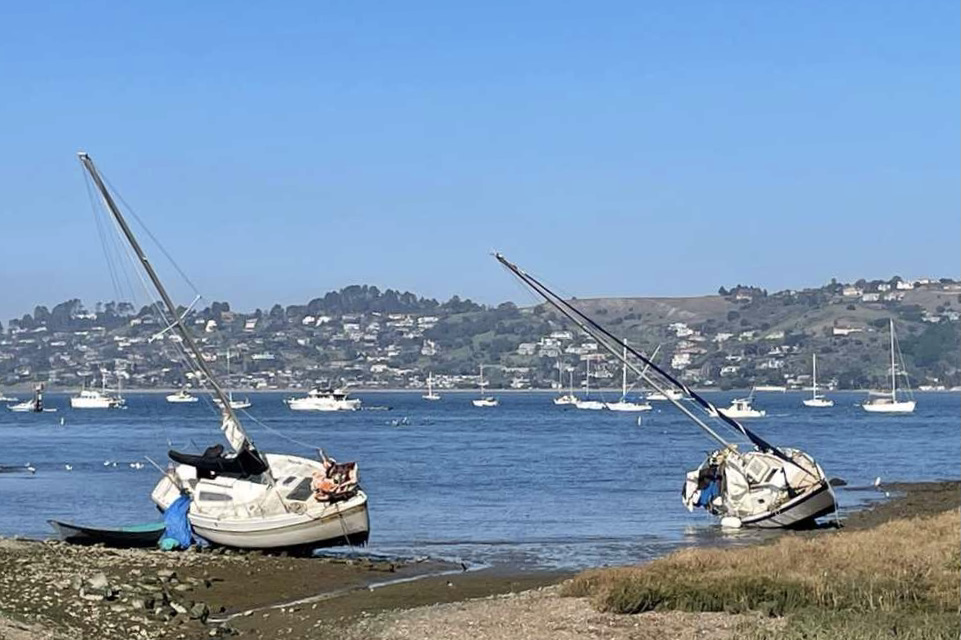
According to a Sausalito PD press release, the owners had initially refused to move the boats and were later each issued a 72-hour warning. Failure to comply would result in the boats being towed and impounded at the owners’ expense. As the foreshore on which they had landed is under the jurisdiction of the City of Sausalito, the unnamed skippers were also cited under the city’s Municipal Code section 16.04.070 — a misdemeanor with a potential penalty of $500. (Not a lot to pay for a bottom cleaning, if you can get away with it.) According to comments on social media from a local who witnessed the scene, “As soon as the police left, the work resumed.”
However, the situation later went sideways. While one of the boats successfully sailed away, the other remained, became stuck in the mud, heeled over, and filled with water, its removal now requiring a salvage team. Pollutants emerged from the sunken vessel, and Parker Diving Service was called in to place a protective boom around the vessel in an attempt to contain contaminants that were seeping into the Bay.
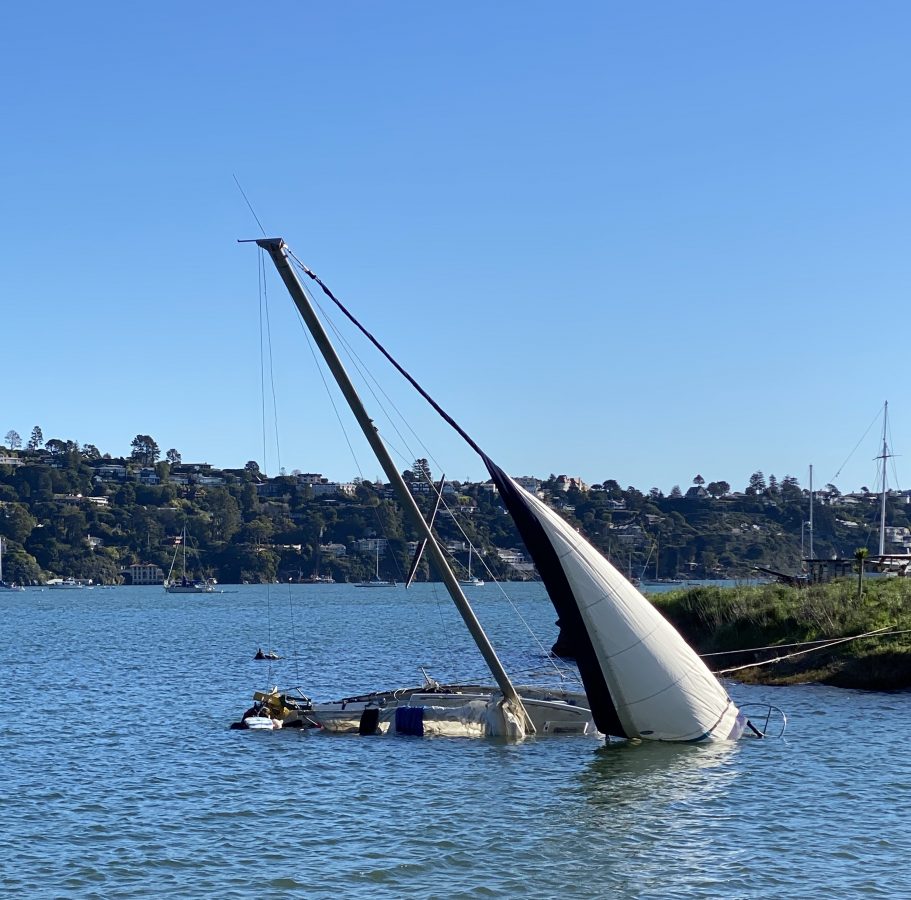
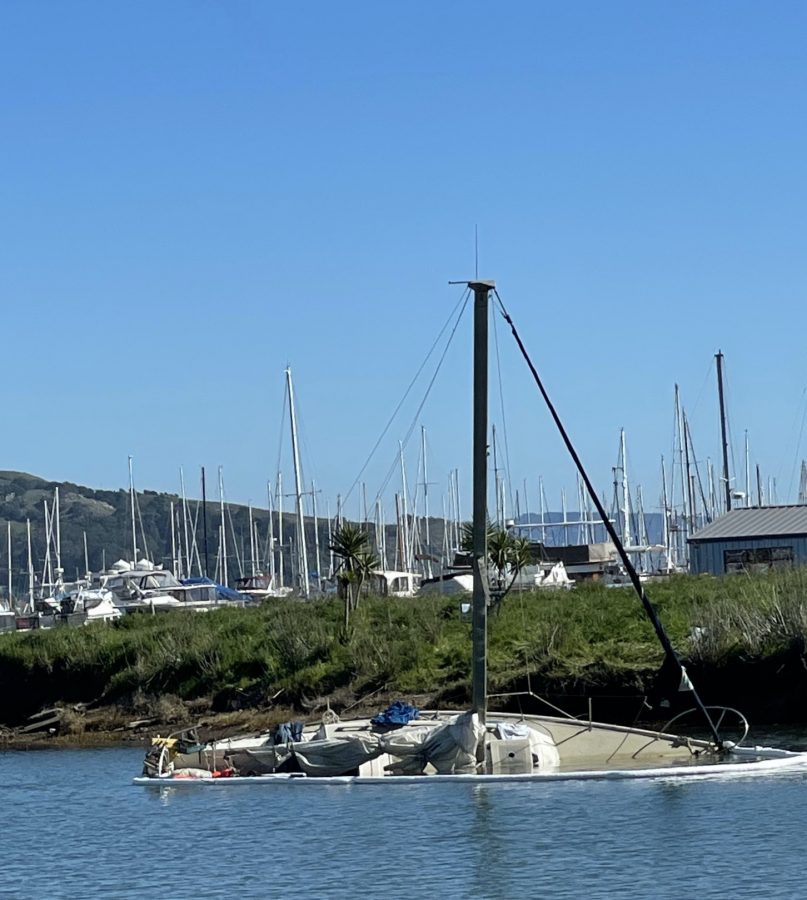
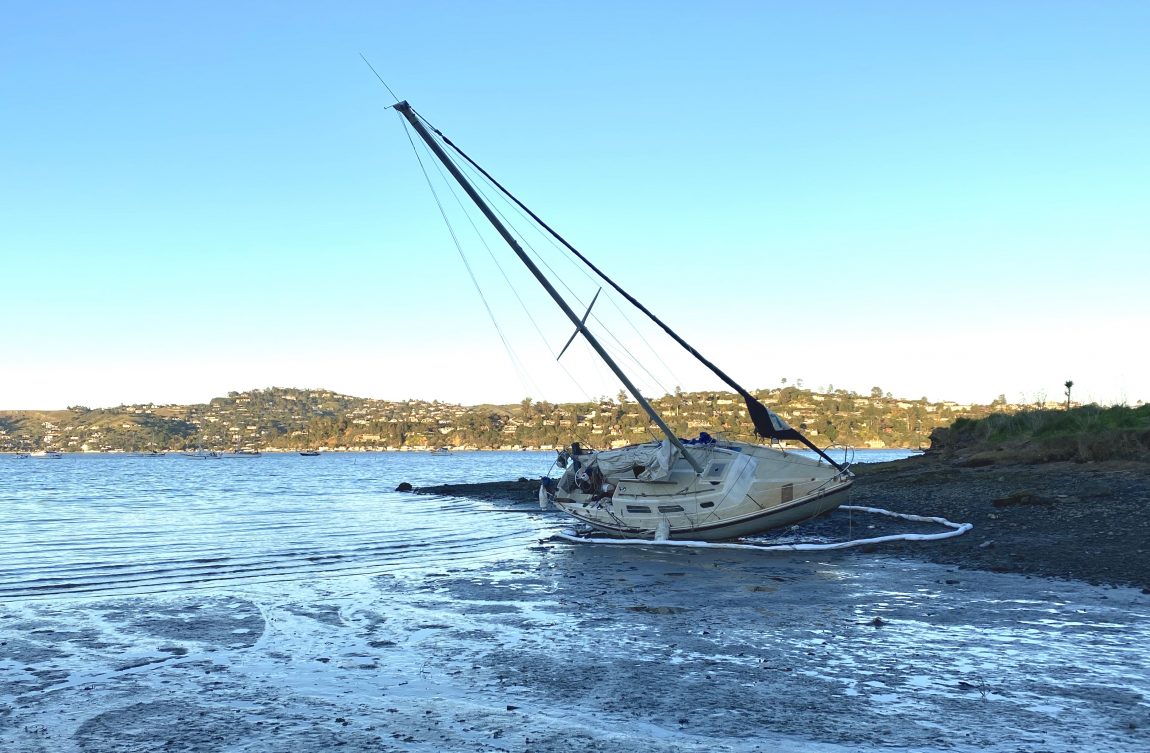
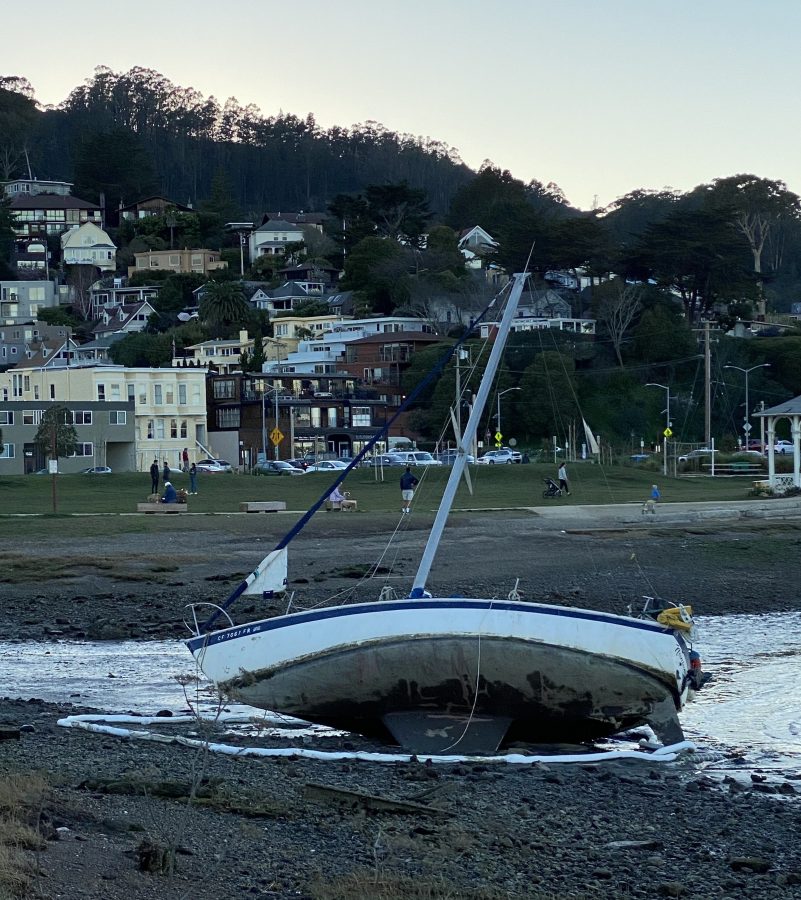
On Thursday, the remaining sailboat was salvaged by a Parker Diving team, with boats from the PD, Coast Guard and RBRA keeping the area clear of onlookers. When Latitude 38 arrived on the scene the sunken vessel was being pumped out in preparation for towing.
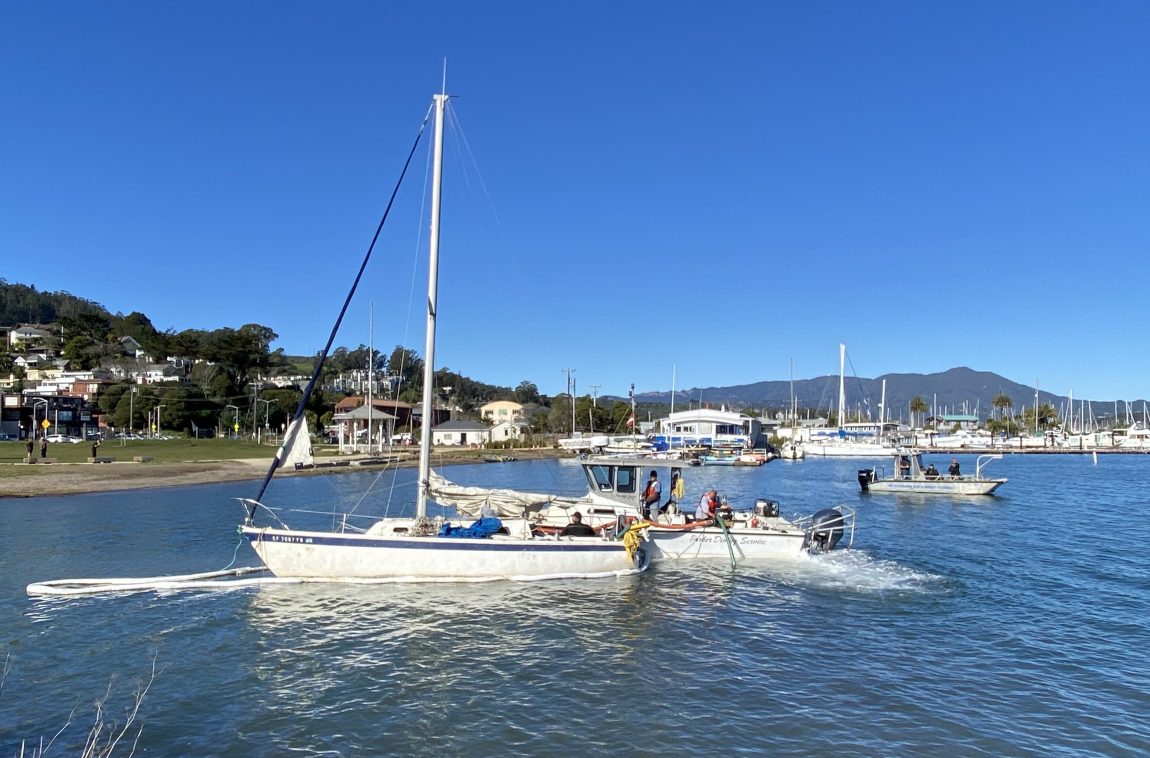
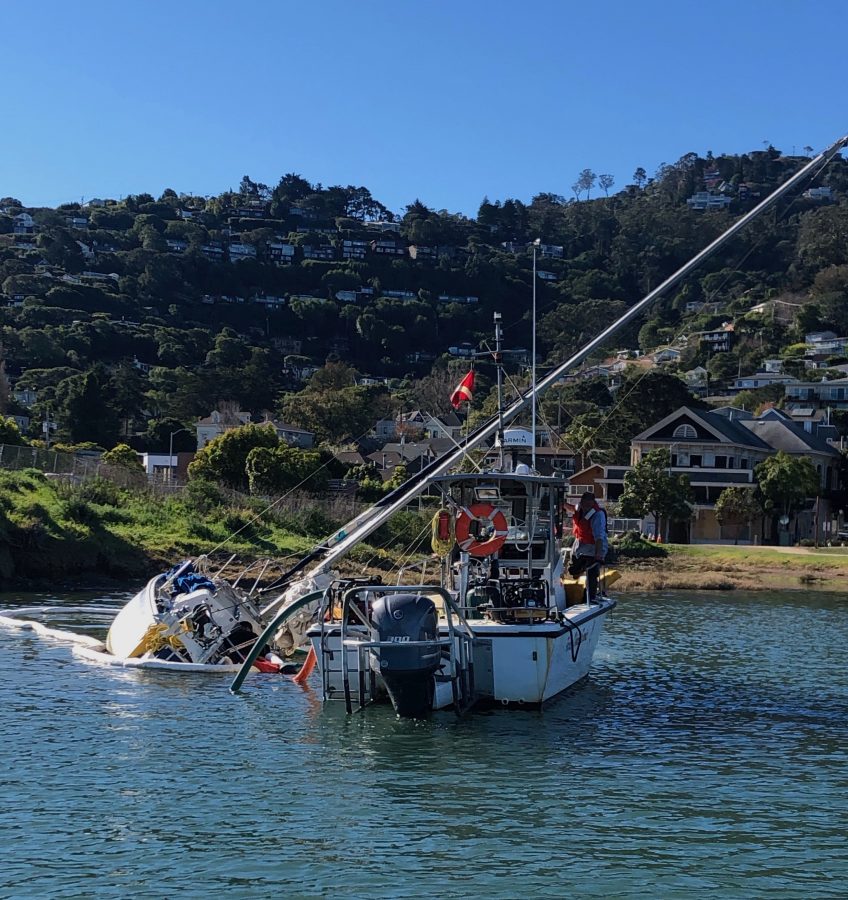
Richardson Bay Regional Agency acting harbormaster Jim Malcolm told us the Sausalito police had called him on Saturday morning to seek the agency’s expertise and assistance. A former USCG boatswain’s mate master chief petty officer, Malcom told us they had a saying in the Coast Guard, “When ships were made of wood and men were made of steel …” He acknowledged the practice of careening boats to clean and work on the bottoms was not uncommon back in the days when there were no engines or other potential threats to the environment. But he added that it required a certain degree of knowledge and daring. “It’s not just as easy as beaching your boat and waiting for the tide to float it.”
The salvaged boat has been towed away, its fate as yet unknown, but we understand it will not be returning to its anchorage on Richardson Bay.
The Resourceful Sailor: Removing External Chainplates — An Unusual Tool Belt
What do a Subaru scissor jack, a harmonic balancer puller and a hammer have in common? The Resourceful Sailor used all three while removing the chainplates from Sampaguita, a Pacific Seacraft Flicka 20 sailboat. It was determined while re-rigging that inspection, possible replacement and re-bedding were in order. Sampaguita has 10 externally mounted chainplates, through-bolted to the hull with stainless steel carriage bolts and nuts. Removing the inside nuts was not troublesome, but driving the bolts out ranged from slightly awkward to “are you kidding me?” This difficulty was due to the tenacious adhesive/sealant that still securely glued them in their holes. This installment will review the various tools and techniques the Resourceful Sailor used to drive these bolts out.
Carriage bolts have domed heads that provide little to no grip. The shank directly below the head is square, locking the bolt in the chainplate, and preventing rotation as the nut is tightened or loosened on the inside. They needed pushing out enough to use either a vise grip on the dome or a wrench on the under-head square section, while not marring the chainplates I might want to re-use. Once they were driven out a little, rotation was easy enough, and removal by twisting was possible. Overcoming that initial bond was everything.
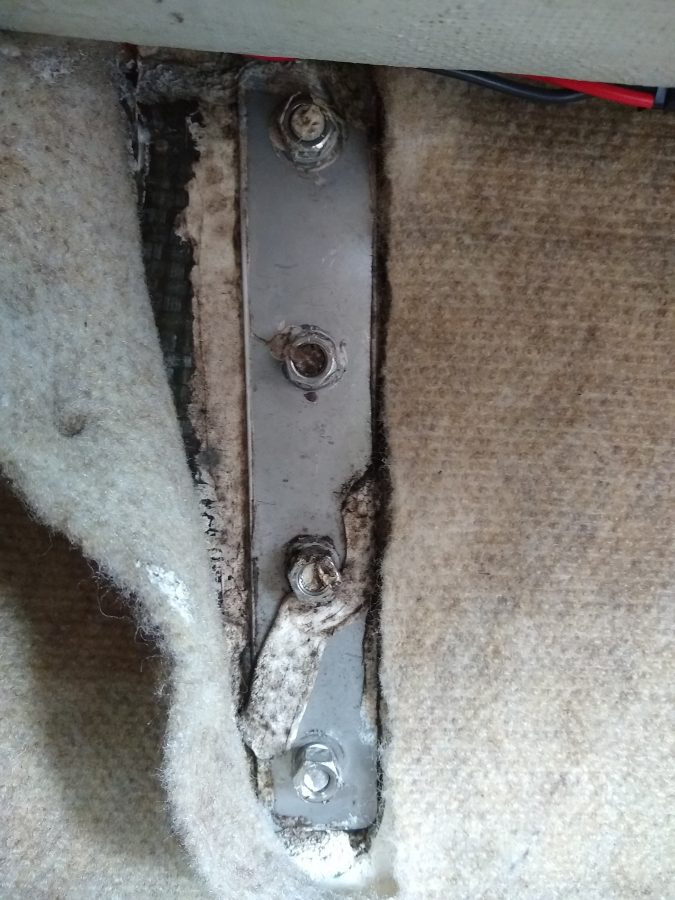
I removed the aft lower and the bowsprit chainplates first, as they were low-hanging fruit as far as accessibility goes. There was enough swinging room for a hammer and punch (a hex bolt) to do the trick. Next came the fore lowers, a step up the ladder of difficulty. Their approach was a little more awkward. Shelving required a bit more boat yoga, and a bulkhead and bulwark troubled my right-handed angle of attack, but I eventually got enough driving force with the hammer and punch. The main shroud plates were even more challenging due to their alignment with the bulkhead. There was only just enough access to the nuts to back them off. Driving them out required a longer punch bolt with a janky, angled approach and a careful swing.
The pairs had become increasingly tedious and challenging, but were nothing compared to what was in store. Moving on to the dual backstay chainplates required a completely different approach.
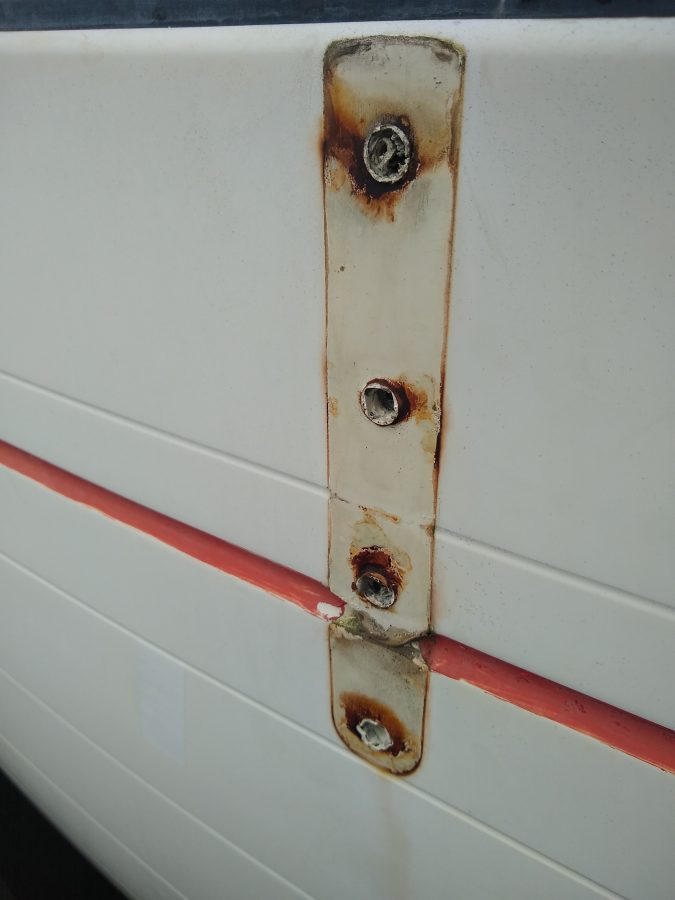
Sampaguita has two full backstays with chainplates fastened in each upper corner of the transom. Access to the port side was by crawling headfirst into the coffin-like quarter berth, rolling over onto my back, and reaching up into the space between the transom and the coaming. Removing the nuts was easy. However, with only a few inches to work with and an overhead reach, how could I leverage the bolts out? An internet search turned up the idea of using a car jack. I thought, “There is no way my Subaru scissor jack will fit up in there,” but I had to try. Would you believe it worked?
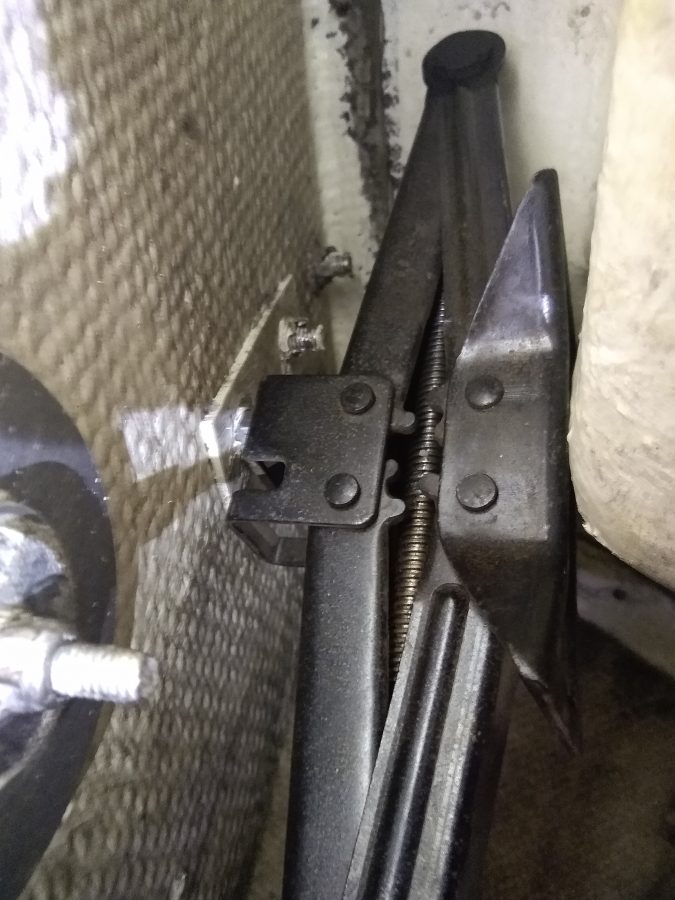
Wedged with the base against the coaming and the head on the carriage bolt, I used an adjustable wrench to open the jack. With the ability to lift a car, it had no trouble pushing out the bolt. The challenging part was positioning it in the tight spot and not dropping the six-pound angular steel artifact onto my face. Amazingly, it served to push out all three bolts on the port side.
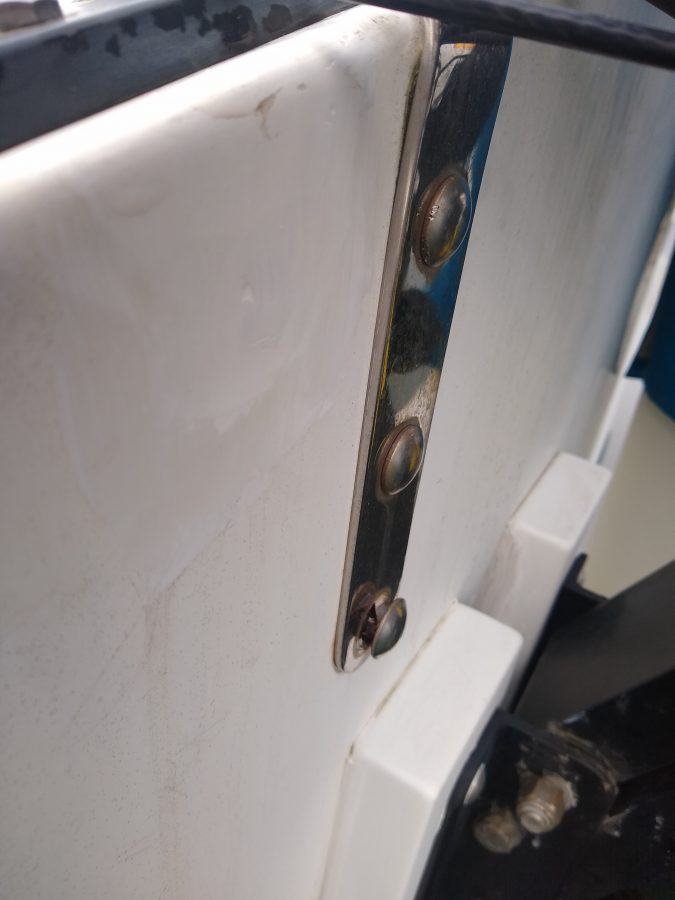
The starboard side would be a bit of a finale regarding the challenge. Access was through a small cockpit locker. Too small for an adult to climb in. It required blindly reaching inside and then back up into the space between the transom and the coaming. I rigged a mirror to see what my hands were doing, and removing the nuts was, again, simple. I tried the jack again to drive out the bolts, but it was too big, heavy, and awkward to get into position. There were also other obstacles in the way, mainly the bilge discharge hose. Thinking outside the box now, I wracked my brain about what I might already own that could work.
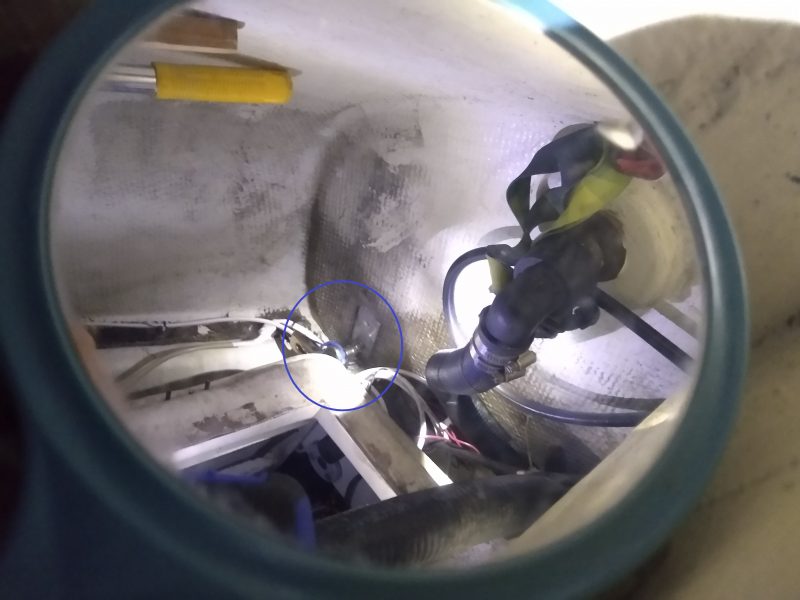
I remembered the harmonic balancer puller I’d purchased several years ago for an old Johnson outboard repair. Could I make that work? A harmonic balancer puller has a yoke with a center bolt. The yoke attaches to the balancer (imagine a wheel), and the center bolt aligns with the crankshaft (like an axle). Tighten down the center bolt, and the crankshaft remains stationary, pulling off the balancer. In this case, I intended to use it contrarily. The yoke would remain fast against the coaming, while tightening the center bolt would drive the fastener out.
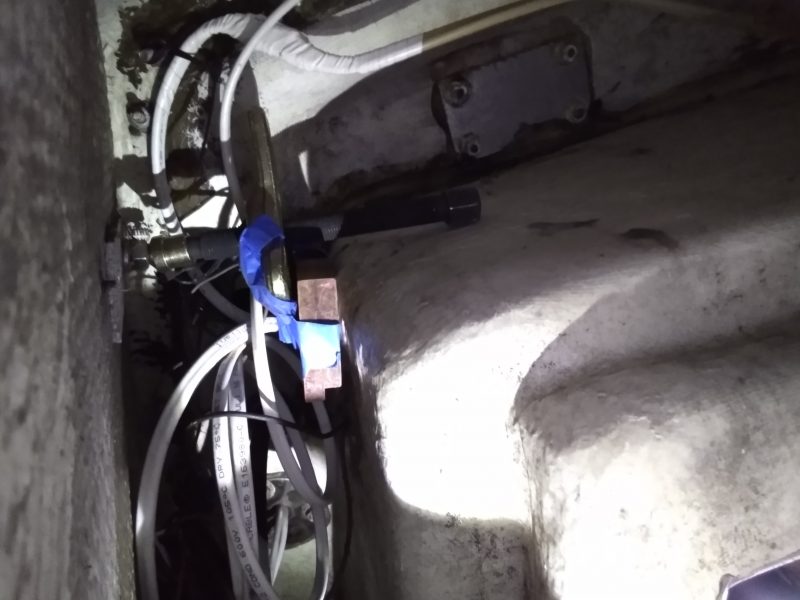
It was compact enough to handle and wedge into position, again utilizing the mirror for sight. The first tedious task was positioning. It took patience and perseverance to get it just right. That, and a block of wood taped to it as a spacer. Once it was in place, the limited access allowed the bolt about 1/16th of a turn at a time. Flip the wrench over to get a different angle, and take another 1/16th of a turn. Repeat. Again and again and again. Did I mention the center bolt has fine threads? Eventually, it pushed the fastener out. This technique worked for all three bolts on this chainplate. One trick that helped was putting the nuts back on the ends but only half-threading them on. They left a little cavity that captured the pointy end of the center bolt, helping it stay in place.
The next time you wonder what tool could work for a seemingly impossible boat project, there is often an answer outside the box. The internet led to the scissor jack, which led to my thinking of the balancer puller, a tool not used in years. What unusual tools have you used in a bind? The Resourceful Sailor hopes to inspire creative solutions for troublesome boat problems. Remember, keep them prudent and safe, and have a blast.
Shearwater Sailing: Building Sailing Skills and Community in Northern California
Upcoming Opportunities:
March 23, Monterey to San Francisco
March 26, SailGP viewing and sailing on S.F. Bay
March 29 – April 29, private charter daysails on S.F. Bay
April 8-10, ASA 106 Advanced Coastal Cruising (offshore)
April 30, San Francisco to Monterey (FULL)
For more information and booking visit: https://www.shearwatersailing.net/booking
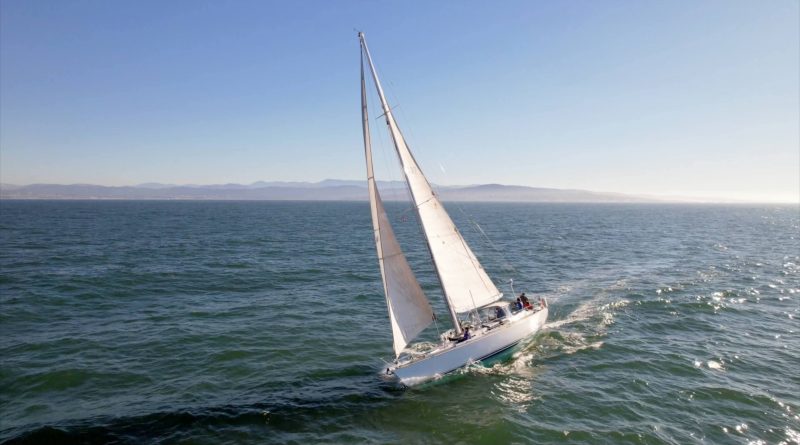
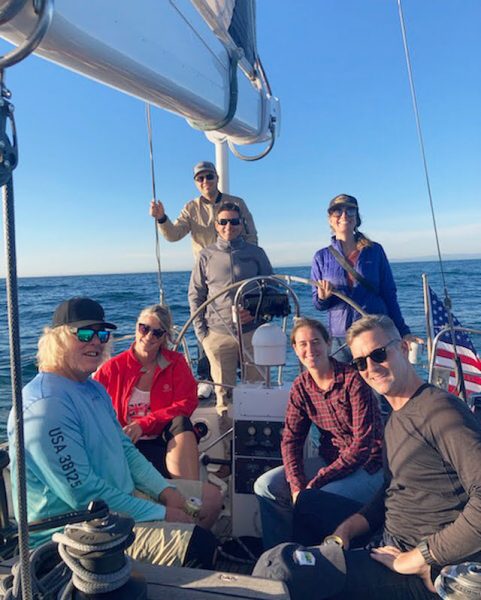
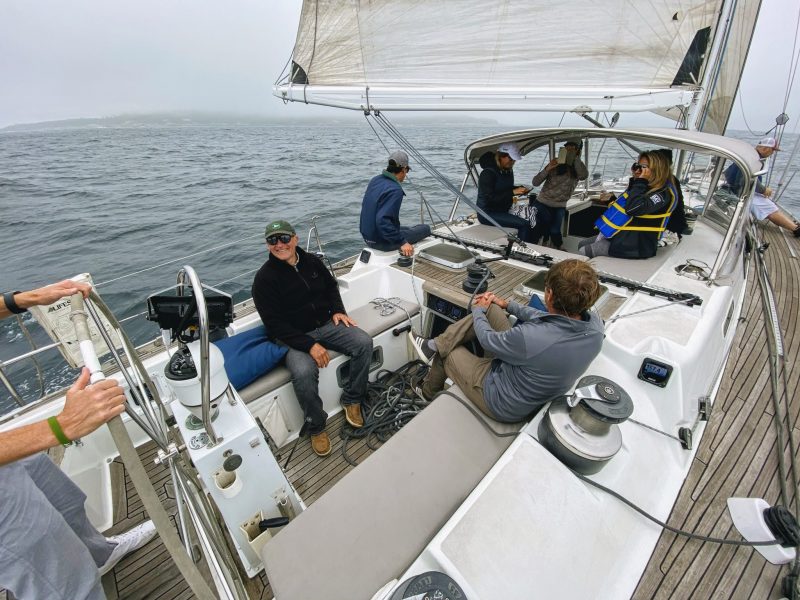
Sausalito Community Boating Center Hosts 9th Annual Herring Festival
If you’ve spent any time on or near the water in recent weeks (which we hope you have), you may have noticed the excessive bird activity. Yes folks, we are in the midst of herring season, the gulls and seals’ favorite time of year. Ours too! Because we get to enjoy eating the herring that are caught, and we get to enjoy Sausalito Community Boating Center‘s annual Herring Festival.
This year the festival is a hybrid event — live and virtual. The in-person event will be held in the Spinnaker Restaurant’s Banquet Room with cooking demonstrations, live entertainment, and an amazing dinner, featuring the Bay Area’s famous herring prepared in a variety of fashions — “You can barbecue it, boil it, broil it, bake it, sauté it …” Oh, wait, that was shrimp. But a quick peek at the menu shows herring will be offered as pickled, swimming in a curry cream, and smoked. There is, of course, a full menu on offer, including “Grilled Herring with White Beans and Pea Sprouts.” YUM! Is there a herring dish for dessert too?
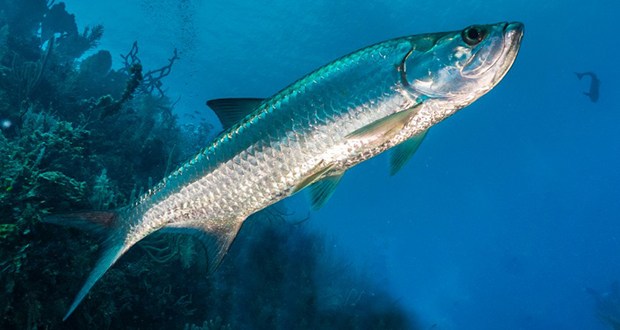
Food isn’t the only feature of the Herring Festival. There is a silent auction with some value-packed items on the table, and raffles that could land you a sail aboard the Matthew Turner, kayak rental with Sea Trek, gift certificates for several local outlets, and even a Seaweed Camp with Flora and Fungi Adventures — yes, you read that right, a Seaweed Camp. Check out the full list of raffle items here.
SCBC’s mission is “to preserve a gathering place on Sausalito’s waterfront to engage and educate the public about our rich maritime history and small craft heritage through affordable direct experience.” By participating in the Herring Festival, you will be supporting this mission and helping the organization build their facilities and fleet, which will provide affordable access and education.
“We will offer waterfront education and recreation for all abilities through Sausalito Parks and Recreation. Maritime skills training on the water will target local youth and underserved community members. Experiential youth learning programs in collaboration with local schools will use a STEM (Science, Technology, Engineering and Math)-based curriculum.”
SCBC at Cass Gidley Marina is a 501(c)(3) nonprofit established to create and maintain a community place that provides affordable access to boats and the water, preserves maritime heritage through education and skill-building, and promotes environmental stewardship of the local Bay ecosystem. You can learn more here.
The center’s volunteers and crew have been working hard to complete the project and open their doors to the community this spring. They’re building docks, building boats, and developing programming. Volunteers have also been helping onsite with the Second Sunday work parties, which bring together many hands and make the work lighter. If you would like to get involved or make a donation you can find the details here.
Herring Festival Date and Details:
Live Event:
Thursday, February 24
5:30–6:00 p.m. Cocktails | 6:00-8:00 p.m. Dinner — You can even have your dinner delivered to your door!
If you can’t make it in person, join the free online event on Zoom.
Get your tickets here: https://scbc.betterworld.org/events/scbc-herring-festival
A Bridge Too Far for Jeff Bezos?
How much is too much?
At what point do wealth and the trappings of success become excessive, extravagant and extreme? Is there a line, or an unspoken social contract?
In the Netherlands, a proposal for the temporary dismantling of a historic bridge to make way for a new superyacht reportedly built for West Coast sailor Jeff Bezos was, for some people, a step too far. Stories about the bridge quickly rippled through the internet, stoked ire, and now seem to symbolize an idea both incontrovertible and difficult to articulate.
In early February, a Dutch public broadcaster announced that the city of Rotterdam had said that it would dismantle the middle section of 95-year-old Koningshaven Bridge to accommodate the passage of Y721, the 417-ft, three-masted sailing megayacht said to have been commissioned for the founder of Amazon. The New York Times reported that a few days after the initial announcement — and in the midst of a brewing kerfuffle — officials said they had not yet approved the plan, but had received a request from the shipbuilder, Oceanco. In a statement, the city said it would assess the environmental and economic effects of the plans, and that Oceanco would cover the cost of deconstruction, and restore the bridge “immediately afterward.”
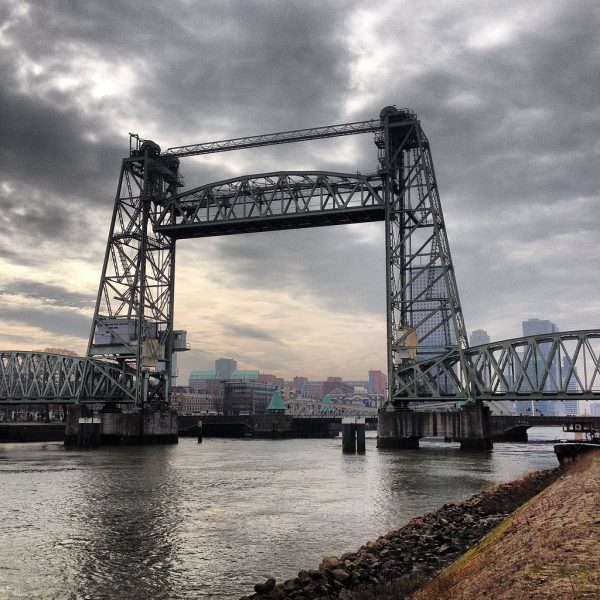
Decommissioned in 1994 after being replaced by a tunnel, the bridge — known to locals as ‘De Hef’ — is a national heritage landmark of restored, postwar Rotterdam. A Dutch writer told the Times that when the city proposed removing the shuttered bridge in the 1990s, there were “major protests.”
The notion of messing with De Hef has sparked new protests, as nearly 5,000 people have signed up on Facebook for the event, “Throwing eggs at superyacht Jeff Bezos.”
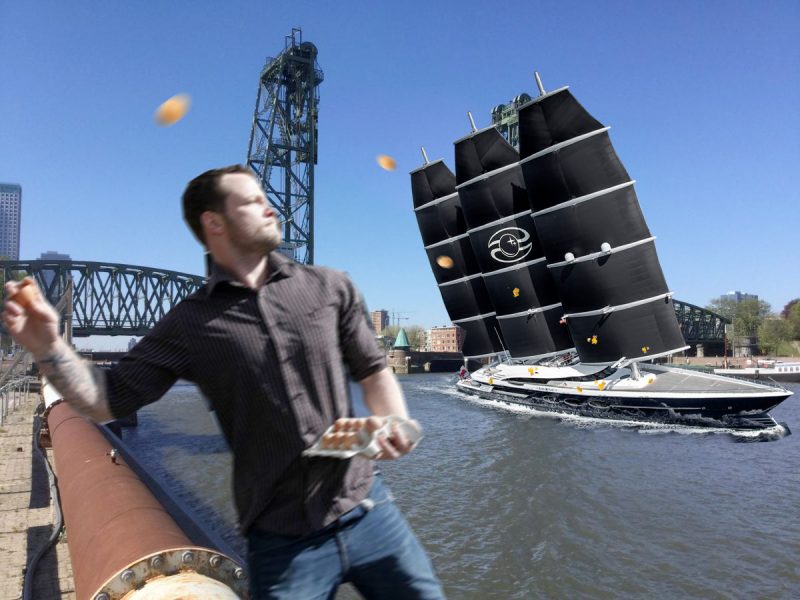
What, exactly, are people so outraged about? What was the transgression? We ask again, where is the line? Is it boats over a certain footage — say 400-ft? Is it when you have a 246-ft tender for the superyacht? Is it when your boat is so big that you have to literally dismantle public infrastructure to pass through?
Has the pendulum swung too far? Did the pendulum climb aboard a rocket curiously shaped like a penis and blast off into space? When does one go from being successful and rich to being ostentatious? In the parlance of our time, at what point does someone become a douche?
This is where extremes start to color the debate. Figures like Jeff Bezos are portrayed either as cartoonish, mustache-twisting villains, as Dickens characters, as Bond villains, or conversely, as heroes, as job creators, as John Galt incarnate, as visionaries for whom we, as consumers, reap the benefits of their genius.
Titans of industry — especially Jeff Bezos — become lightning rods for larger political conversations.

So what does the De Hef bridge really symbolize?
This is where we drift into territory that surely all of you come to this sailing magazine and website to discuss: marginal tax rates, capital-gains taxes, and the success and failures of the monetary policies of capitalism and socialism.
Amazon has paid very little in corporate and federal taxes over the last few years, and cities often pay Amazon millions of dollars to open new warehouses. “Where in Wealth of Nations did Adam Smith write that this is how the ‘Invisible Hand’ should work?” said one Latitude reader when we wrote about Jeff Bezos’ “excesses” a few months ago. “[Bezos’] fortune is a policy failure, an indictment of a tax and transfer system and a business and regulatory environment designed to supercharging the earnings of and encouraging wealth accumulation among the few,” The Atlantic wrote.
Most Latitude readers were overwhelmingly supportive of Bezos in our previous story. “A person has the right to spend what he earns on his creation without being sent on a guilt trip for doing so,” said one reader. “When I make my billions, I will be able to judge Jeff Bezos,” said another. Several people said that Bezos had created millions of jobs, and that some amount of wealth circulates, recycles, and trickles down.
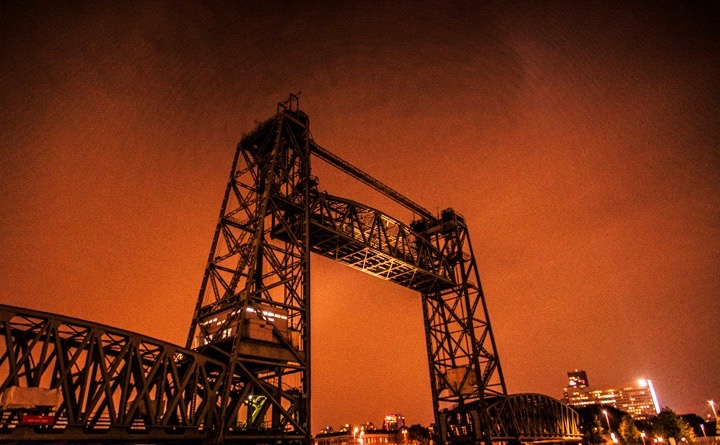
If you comment on this story, then we challenge you to go beyond the usual talking points and the extreme tropes of what billionaires are perceived to be — either the hero or the villain. We are asking for nuance. We are asking: How much is too much? What would be a bridge too far?


